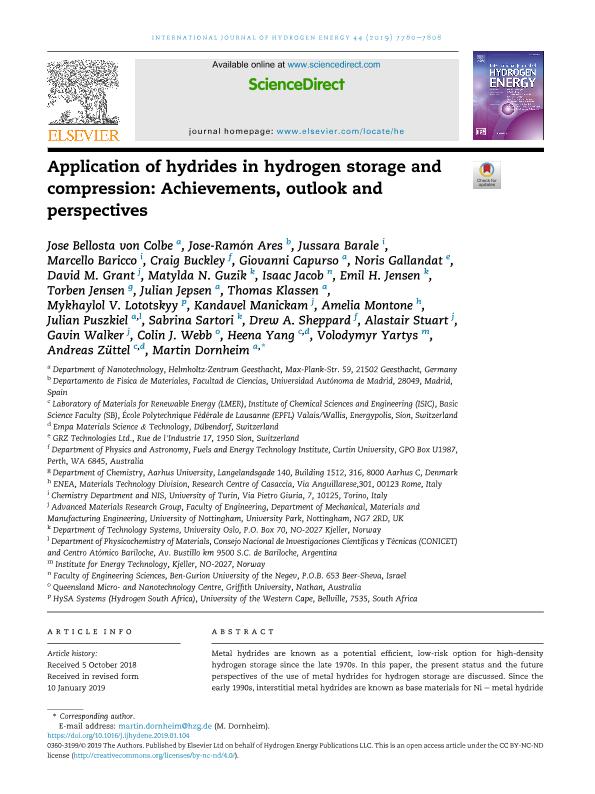Artículo
Application of hydrides in hydrogen storage and compression: Achievements, outlook and perspectives
Bellosta von Colbe, Jose; Ares Fernández, José Ramón; Jussara, Barale; Baricco, Marcello; Buckley, Craig E.; Capurso, Giovanni; Gallandat, Noris; Grant, David M.; Guzik, Matylda N.; Jacob, Isaac; Jensen, Emil H.; Jensen, Torben; Jepsen, Julian; Klassen, Thomas; Lototskyy, Mykhaylol V.; Manickam, Kandavel; Montone, Amelia; Puszkiel, Julián Atilio ; Sartori, Sabrina; Sheppard, Drew A.; Stuart, Alastair; Walker, Gavin; Webb, Colin J.; Yang, Heena; Yartys, Volodymyr; Züttel, Andreas; Dornheim, Martin
; Sartori, Sabrina; Sheppard, Drew A.; Stuart, Alastair; Walker, Gavin; Webb, Colin J.; Yang, Heena; Yartys, Volodymyr; Züttel, Andreas; Dornheim, Martin
 ; Sartori, Sabrina; Sheppard, Drew A.; Stuart, Alastair; Walker, Gavin; Webb, Colin J.; Yang, Heena; Yartys, Volodymyr; Züttel, Andreas; Dornheim, Martin
; Sartori, Sabrina; Sheppard, Drew A.; Stuart, Alastair; Walker, Gavin; Webb, Colin J.; Yang, Heena; Yartys, Volodymyr; Züttel, Andreas; Dornheim, Martin
Fecha de publicación:
03/2019
Editorial:
Pergamon-Elsevier Science Ltd
Revista:
International Journal of Hydrogen Energy
ISSN:
0360-3199
Idioma:
Inglés
Tipo de recurso:
Artículo publicado
Clasificación temática:
Resumen
Metal hydrides are known as a potential efficient, low-risk option for high-density hydrogen storage since the late 1970s. In this paper, the present status and the future perspectives of the use of metal hydrides for hydrogen storage are discussed. Since the early 1990s, interstitial metal hydrides are known as base materials for Ni – metal hydride rechargeable batteries. For hydrogen storage, metal hydride systems have been developed in the 2010s [1] for use in emergency or backup power units, i. e. for stationary applications. With the development and completion of the first submarines of the U212 A series by HDW (now Thyssen Krupp Marine Systems) in 2003 and its export class U214 in 2004, the use of metal hydrides for hydrogen storage in mobile applications has been established, with new application fields coming into focus. In the last decades, a huge number of new intermetallic and partially covalent hydrogen absorbing compounds has been identified and partly more, partly less extensively characterized. In addition, based on the thermodynamic properties of metal hydrides, this class of materials gives the opportunity to develop a new hydrogen compression technology. They allow the direct conversion from thermal energy into the compression of hydrogen gas without the need of any moving parts. Such compressors have been developed and are nowadays commercially available for pressures up to 200 bar. Metal hydride based compressors for higher pressures are under development. Moreover, storage systems consisting of the combination of metal hydrides and high-pressure vessels have been proposed as a realistic solution for on-board hydrogen storage on fuel cell vehicles. In the frame of the “Hydrogen Storage Systems for Mobile and Stationary Applications” Group in the International Energy Agency (IEA) Hydrogen Task 32 “Hydrogen-based energy storage”, different compounds have been and will be scaled-up in the near future and tested in the range of 500 g to several hundred kg for use in hydrogen storage applications.
Palabras clave:
HYDROGEN STORAGE
,
HYDROGEN COMPRESSION
,
METAL HYDRIDES
Archivos asociados
Licencia
Identificadores
Colecciones
Articulos(CCT - PATAGONIA NORTE)
Articulos de CTRO.CIENTIFICO TECNOL.CONICET - PATAGONIA NORTE
Articulos de CTRO.CIENTIFICO TECNOL.CONICET - PATAGONIA NORTE
Citación
Bellosta von Colbe, Jose; Ares Fernández, José Ramón; Jussara, Barale; Baricco, Marcello; Buckley, Craig E.; et al.; Application of hydrides in hydrogen storage and compression: Achievements, outlook and perspectives; Pergamon-Elsevier Science Ltd; International Journal of Hydrogen Energy; 44; 15; 3-2019; 7780-7808
Compartir
Altmétricas



